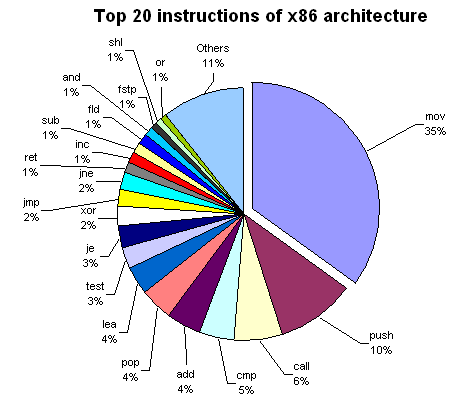![[Home]](http://www.bayleshanks.com/cartoonbayle.png)
Difference between revision 18 and current revision
No diff available.Table of Contents for Programming Languages: a survey

http://www.strchr.com/x86_machine_code_statistics
distribution by instruction length: 1 4.77% 2 17.67% 3 18.72% 4 12.28% 5 13.78% 6 15.60% 7 13.30% 8 2.46% 9 0.01% 10 1.02% 11 0.41%
top 20 instructions: mov 35% push 9.99941228328% call 6.01175433441% cmp 4.62415515721% add 4.31295915369% pop 4.08257419924% lea 3.85953570379% test 2.79400528945% je 2.74316779312% xor 2.44255069057% jmp 2.22421392889% jne 2.19541580958% ret 1.45224801646% inc 1.36320893329% sub 1.32677049662% fld 1.29180135175% and 1.10843373494% fstp 1.03967087864% shl 0.84748751102% or 0.738172200999% Others 10.5436379665%
number of operands: 0 3% 1 37% 2 60%
addressing modes: immediate 20% register 56% absolute address 1% indirect address 23%
instruction formats (note the destination comes first in the following): register-memory 35.4% register-register 26.5% register-immediate 16% memory-register 15.2% memory-immediate 6.8%
" The most popular instruction is MOV (35% of all instructions). Note that PUSH is twice more common than POP. These instructions are used in pairs for preserving EBP, ESI, EDI, and EDX registers across function calls, and PUSH is also used for passing arguments to functions; that's why it is more frequent. CALLs to functions are also very popular.
More than 50% of all code is dedicated to moving things between registers and memory (MOV), passing arguments, saving registers (PUSH, POP), and calling functions (CALL). Only 4th instruction (CMP) and the following ones (ADD, LEA, TEST, XOR) do actual calculations.
From conditional jumps, JE and JNE (equal and not equal) are the most popular. CMP and TEST are commonly used to check conditions. The percentage of the LEA instruction is surprisingly high, because MS VC++ compiler generates it for multiplications by constant (e.g., LEA eax, [eax*4+eax]) and for additions and subtractions when the result should be saved to another register, e.g.:
LEA eax, [ecx+04] LEA eax, [ecx+ecx]
The compiler also pads the code with harmless forms of LEA (for example, the padding may be LEA edi, [edi]). As is easy to see, the top 20 instructions include all logical operations (AND, XOR, OR) except NOT.
Though LAME encoder uses MMX technology instructions, their share in the whole code of the program is very low. Two FPU instructions (FLD and FSTP) appears in the top 20.
But what about other instructions? It turns out that multiplication and division are very rare: IMUL takes 0.13%, IDIV takes 0.04%, and both MUL and DIV do 0.02%. Even string operations such as REPZ SCASB or REPZ MOVSB are more common (0.32%) than all IMULs and IDIVs. On the contrary, FMUL is more common than FADD (0.71% versus 0.27%). "
also at [1]